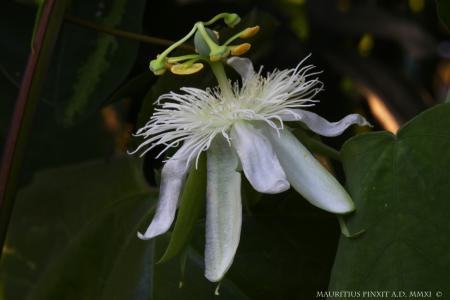
SUBGENUS: passiflora
SUPERSECTION: stipulata
SECTION: granadillastrum
GEOGRAPHICAL DISTRIBUTION OR ORIGIN:
Messico centrale, Sud America, Columbia e Venezuela.
MINIMUM TEMPERATURE: 5 °C
IDEAL MINIMUM TEMPERATURE: 8 °C
SYNONYMS: P. adenophylla Mast., P. alba Link & Otto, P. atomaria Planch.
ETYMOLOGY: From the Latin prefix sub- almost, similar to, less, and from peltatus for the base of the leaves slightly shaped like a shield, almost equipped with small shields (Latin pelta, shield). It is said of the leaf whose petiole is inserted more or less in the middle of the leaf flap, which is shaped like a shield.
NOTES: Chromosomes: n=9, 2n=18
DESCRIPTION:
P. subpeltata is often called P. alba. This synonym is simpler and easier to memorise, as the plant has white flowers with a diameter of about 5 cm. The upper surface of the sepals, the petals and the 5 series of filaments of the large, vaporous corona are all white. The sepals carry, almost at the apex, a weak hook, very long and flat.
Flowering is continuous and abundant meaning that the whiteness of the flowers stands out constantly against the dense vegetation of trilobate leaves of a beautiful glaucous green. The plant's fruiting is equally abundant and continuous, consisting of globose fruits which, even when ripe, retain the same glaucous colour of the leaves.
Growth is vigorous and the plant, which is hairless in its entirety, often becomes dense and tangled. It is, therefore, necessary to provide it with adequate supports, such as a large espalier, so as to better enjoy its continuous flowering.
P. subpeltata is highly valued by collectors for its adaptability and generous flowering, although it is not sufficiently hardy to be grown in the open ground in northern Italy. In winter, it is best not to keep it at temperatures below 5°C. However, a temperature of 8°C is ideal for keeping it safely through the coldest months of the year.
It requires soil rich in humus and weekly liquid fertilisation during the period of greatest growth. It is necessary to provide it with large pots (not less than 25-30 cm in diameter) to achieve rapid and vigorous growth.
The
substantial fruit and, therefore, seed production guarantees reproduction from
seeds without difficulty. Flowering will take place no earlier than two years
after germination. Propagation from cuttings is useful to shorten the time.